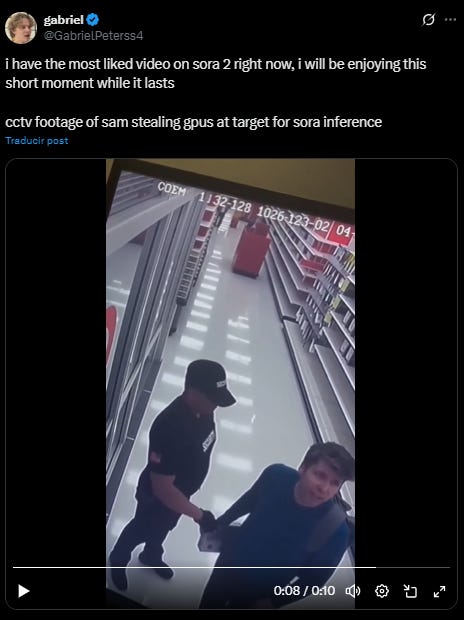Sora 2 may be the ChatGPT moment for video generation (and it's scary)
Sora 2 points to a future in which seeing is no longer believing
This morning, while scrolling through my feed, I saw what looked like a security camera footage of Sam Altman, the CEO of OpenAI, stealing a box of GPUs from a Target store. It looked incredibly real at first, but then I realized it was a video generated using Sora 2, OpenAI’s latest video generation model. In that moment, I felt both awe at how far the technology has advanced and unease about where it might lead.
As someone who’s passionate about AI, I’m excited by the creative possibilities that Sora 2 brings. At the same time, I’m also concerned about its broader implications. Sora 2 isn’t just another tech novelty. It’s a powerful tool that could represent a major shift in how we create and consume media.
P.S. I shared one more Sora 2 invite code in my paid-subscriber chat here on Substack as a thank-you for the support. The invite code is valid for up to 4 people.
Everything you need to know about Sora 2
Sora 2 represents a major leap forward in video and audio capabilities compared to its predecessor. In fact, the Sora team believes this release might be “GPT-3.5 moment” for video generation—a sudden jump in realism and complexity, much like what we saw with language models a few years ago.
So, what exactly can this model do? In short, a lot.
Here’s a summary of what Sora 2 can do:
It can generate short video clips with amazing physical realism and synchronized audio
It follows the laws of physics more accurately than previous models
It syncs dialogue, lip movements, and sound effects. Speech is convincingly timed to AI-generated voices, and the ambient noise sounds natural within the scenes
It has a cameo feature that allows real-world characters (you or any person, animal, or even objects) to be inserted into AI-generated scenes
While Sora is far from perfect—it still makes plenty of mistakes, especially in fine details like text on signs or realistic human hands—it marks a meaningful step toward AI capable of blurring the line between real footage and AI-generated content.
The Impact of Sora 2 on Social Media
Just 24 hours after its release, Sora 2 has already made a significant impact across social media. Its success has been seen not only through a newly launched dedicated app but also on existing platforms like X.
OpenAI didn’t introduce a new AI model. It rolled out an entirely new social experience built around it.
The company launched Sora, an invite-only iOS app that functions like a TikTok-style video feed, except all the content is generated using Sora 2. Within the app, users can create AI videos, post them to a dynamic feed, remix each other’s work, and even collaborate through shared cameos. In many ways, OpenAI has built its own mini social network for AI-generated content. This bold move has led some in the tech industry to view it as a potential challenger to platforms like TikTok and Instagram. What began as speculation about OpenAI entering the social media space has now become a reality.




